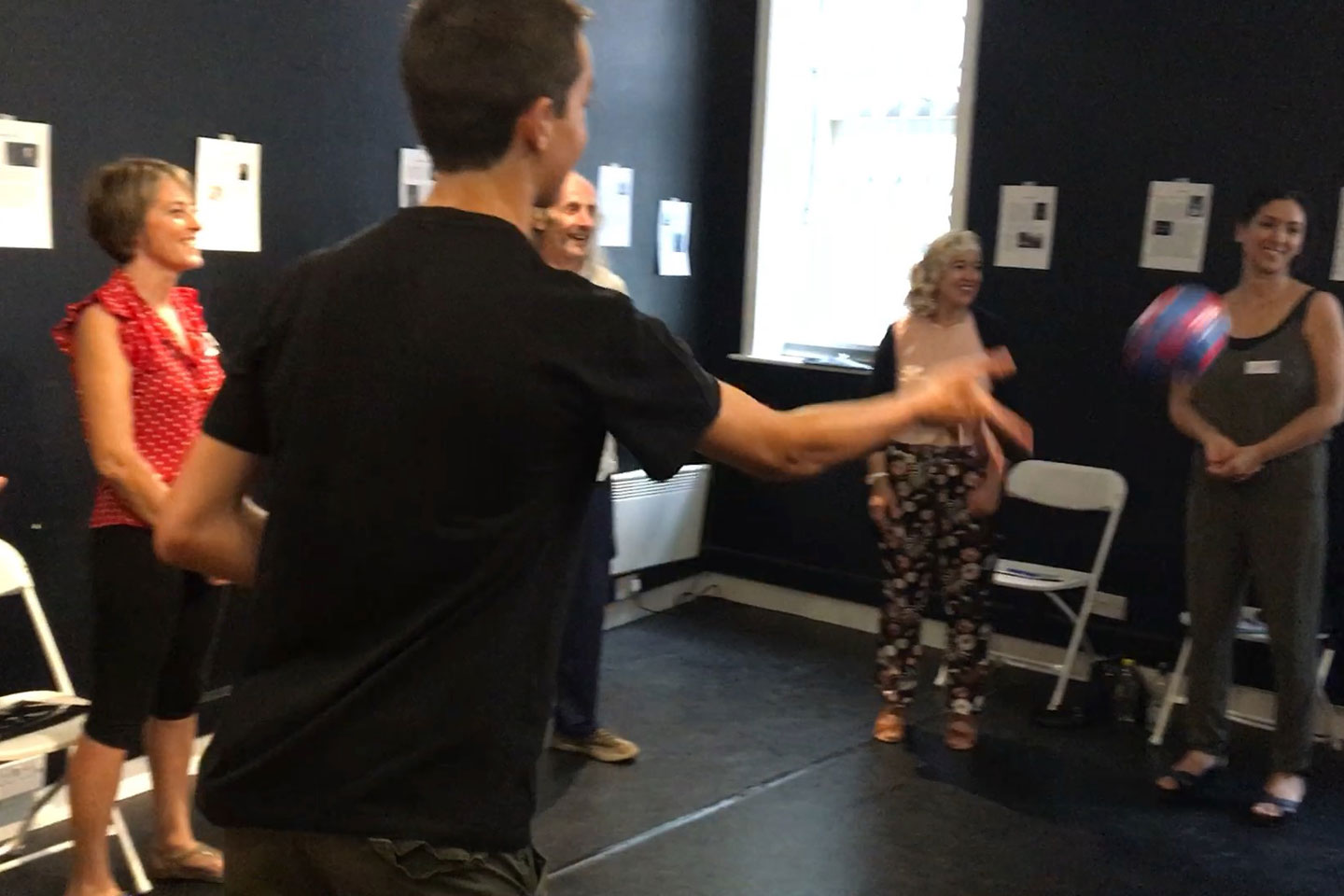
The biggest fear of those teachers who don’t have a solid experience in teaching through games and drama is to look awkward and not credible in the eyes of your students. Well, let’s talk about it. Sometimes language teachers who start to develop an interest in teaching languages through drama have little experience in acting, improvising or even less in teaching drama. This is very common. As a consequence of the lack of experience in teaching theatre, some teachers might feel very uncomfortable in proposing playful activities and drama exercises in class. Very often they end up to think that using drama for teaching necessarily means wearing a funny hat, or acting in front of the students, or analysing a drama script and playing it out. Actually, teaching through drama can mean all of those things, though there is more beyond that. That’s a good news, isn’t it? In this article I’m going to teach you three exercises that you will love if you belong to the community of language teachers with little or no experience in acting and teaching drama.
What could you start with if you don’t feel confident in delivering drama exercises?
In my opinion and according to my experience, language games are the simplest exercises to deliver above all the drama-based exercises. You might remember the classification of drama approaches by Shin-Mei Kao and Cecily O’Neill (find out more about that here: ‘The 7 types of drama exercises for teaching languages’) where there are seven types of approaches in drama for L2 teaching and three categories: closed/ controlled approaches, semi controlled approaches and open communication approaches. The easiest to deliver types of exercises belong to the closed/ controlled approaches. Scripted role-plays, dramatised stories and language games belong to this category. They are pretty easy to deliver because they are based on precise instructions, the roles are fixed and the goal is to practise and absorb specific grammar structures or vocabulary.
Easy to deliver: that easy?
Before we dive into the examples I selected for you, let me be clear about what I mean by ‘easy to deliver’. Once you find a suitable exercise within the closed/ controlled category you will need to prepare the instructions and make sure the students follow your guidelines accurately, for instance: to read, memorise and perform a dialogue where they will pretend to be in a restaurant. Your feedback will be on the accuracy only and no acting skills or creative effort will be required. You will be able to involve even the shyest student in the group if you will keep the focus on the drill, rather than on the performance. That is relatively, say, ‘easy’ because it is closer to a number of L2 exercises we commonly find in L2 textbooks.
Why starting from language games
That said, let’s get back to the language games and the reason why I suggest to start with these ones if you are keen to introduce some drama work in your lessons, but you are not sure about where to start. Language games are great for exploring specific grammar structures, vocabulary and communicative functions that you have previously introduced through a text or a video-clip or a song, for instance. In Learn English through Drama training format we use drama, of course, for introducing new lexical units to the students for the first time. But let’s say you want to stick to your textbook and its guidelines for now: the majority of the textbooks proposes dialogues, texts or videos in order to present new lexical units. So, once you have presented the new vocabulary and grammar, you will need to make the students analyse and practise what they have just received. At this point you will launch a grammar game (or a series of games) because you want your students to have fun while they drill and memorise. Remember, this is not yet the stage where you ask them to get creative and to personalise what they have been learning. On the contrary, you will expect accuracy only. You want them to correctly execute the instructions. This is about putting down solid basis. The time for creativity will come.
3 language games you can propose in your next lesson
Here are three language games you can put into practise the next time you will step into your classroom.
#1- Use a ball for marking turns
Never underestimate the power of toys. Even the most formal lesson can get a twist when we use a ball for marking turns. Whenever you need the students to have their turn in doing something (speaking in front of the group or sharing their opinion, for instance) avoid to call out their names. Instead, gently invite a student to have a go by passing a ball to him. Afterwards, invite him to pass the ball to someone else. It could be a small ball, a big ball, a soft toy, anything you like and you feel comfortable in using in the classroom. How to get started with this: think about your next lesson and spot all the exercises and activities where you might use the ball. For instance, you might want to choose the initial moment of the lesson when you revise the previous lessons together with the students, therefore you will ask them questions and they will be supposed to answer. Choose a nice ball (or other object) and remember to bring it with you the next time you will do a lesson.
You might think: ‘Is that all? Just using a ball?’. Yes. Believe me when I say that even a small simple thing like a ball can really change the atmosphere in a class.
#2- Questions & answers drill made fun
Say you need to make your students practise a pattern of questions and answers, for instance: ‘Where are you from? I am from London. And you, where are you from? I am from Cardiff. Etc.’ Invite the students to stand up and to get into a circle. The person who has the ball will speak and say the question out loud, then she will pass the ball to someone else. The second person will say the answer out loud and then the question by passing the ball to a third person in the circle. And so on. The students will repeat the pattern until the exchange of questions and answers will flow smoothly. At that point, the teacher could ask to keep on repeating the pattern, only faster, or she could add a new question.
#3- Competition games
Any close or matching exercise can be turned into a competition game. Just divide the big group into smaller groups and ask each group to choose a name for the team. Give the teams a few minutes for completing a task (for instance, filling in a close exercise they have in their textbook) and then stop the time when it’s over. Keep the correction of the exercise fun and engaging: ask the teams to give their answers only if they are quick enough to take their turn by clapping their hands (or by making any other noise, such as stomping their feet or saying ‘oh-oh’ out loud). Give points to the teams for each correct answer. Do not take off points for incorrect answers – students are playing, having fun and still memorising something new to them. The key things for good competition games are: teams, time (be precise, use a stopwatch), fun correction.
3 recommendations for getting started with the right foot
Now you have something you can start with. I can bet you feel ready to test the three games. Well, then allow me to give you three recommendations before you put the games into practice.
Invite the student for getting them involved
Firstly, pay attention to the way you will launch the language games. Better not to anticipate the game by saying ‘Now we are going to do a game.’ Try to avoid it. Better invite the students: ‘Would you please stand up and get into a circle?’ If the students are not used to games, your instructions might sound weird to them. Don’t worry, just keep smiling in order to reassure them that everything is under control and they are safe in what they are about to do with you.
Bear in mind that, when people are asked to stand up, the majority of them goes ‘OMG, what will I be supposed to do now? Why can’t we just sit?’ So, remember to use ‘Would you…’ as an invite to join in the next activity.
Lead and reassure, reassure and lead
Secondly, remember to reassure them by smiling or keeping a relaxed facial expression. Even the simplest language game can turn into an unpleasant experience if the teacher is not able to firmly and gently lead the group. Bear in mind you are in charge of their learning experience.
It doesn’t need to happen all at once
Finally, introduce one exercise at a time. It doesn’t need to happen all at once. In the beginning, was… the ball! Take it easy and start by simply introducing the ball (or other object) in your de-briefing or in specific moments of your lessons. Keep on using it until the students become familiar with the ball and you notice they expect for it to be there. Afterwards, they will be ready for proper games, starting from the ones explained above.
Now, I pass the ball to you, my friend. Give language games a try and enjoy yourself!
Want more support?
Join the Facebook group Independent Language Teachers Collective to get daily advice, tons of free training and to branch out with other independent language teachers like you!
ALSO…
Available only for the Collective members: free list 103 question for sparking engagement in your language lessons.
This is what members say about the freebie:

Join in the Collective and grab your welcome gift:
Join Facebook Group

